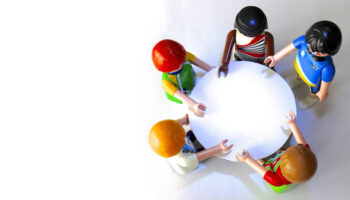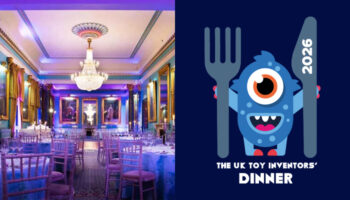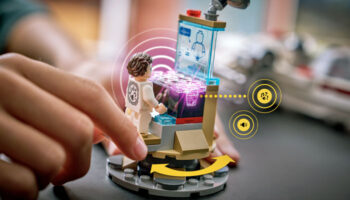As LEGO’s iconic minifigure turns 45, Deej Johnson looks at the design that never looked back…

No matter how much I want the evolution of LEGO’s iconic minifigure to follow the popular depiction, above, the reality’s quite different. In fact, before the mid-seventies, making a figure out of LEGO meant building it yourself… But along with flared trousers and the music of Abba came a revolution: prefabricated people, no less, in the Homemaker theme, as typified by the LEGO Family of 1974.

At the top of each figure is a 2×2 block onto which fits a large head and two somewhat cumbersome ‘shoulders’. The bodies of these figures comprise a mix of standard bricks and plates. Meanwhile, the legs utilise straight or sloping pieces to create trousers, skirts and – in the case of 1977’s roguish cowboys – bowed legs!

While modern LEGO people don’t owe much to these ‘big figs’, they did help create one evergreen legacy: the word minifigure. That’s because their successors are quite definitely ‘mini’ next to their Brobdingnagian counterparts.
Available from 1975 to 1977, however, the original minifigure appears a limbless, expressionless golem next to the iconic design. The truth is that if ever you want to depict a LEGO figure in peaceful death, you could do a lot worse than use one of these.

Two of the most significant breakthroughs in the minifigure’s evolution came in 1978. First, the decision to print smiley, wide-eyed expressions on every head gave the population a ubiquitous, happy-go-lucky look as they mooched about in Castle, Space and City sets. Second, 1978 was also the year that gave minifigures movable legs, arms and hands – the basic figures as we now know them.
While those things may seem like obvious developments in hindsight, it took designer Jens Nygaard Knudsen three years to make it happen. Often referred to as the father of the LEGO minifigure, Jens sadly passed away exactly three years ago today; on February 19th 2020. Speaking to the Danish broadcaster TV2, Knudsen’s widow, Marianne, described her late husband as a “man of ideas”, adding that, “The figure was created so that there would be life in the houses… At the time, LEGO’s houses were empty, but then he drew this man.”

The initial designs – which came with stickers to decorate the basic torso – included a police officer. This was the figure to which LEGO paid special homage on the minifigure’s 40th anniversary, with a respectful update. It’s particularly satisfying to note that the 2018 policeman came with a tile printed to resemble the set in which the primogeniture appeared.

The next significant evolution came with the 1989 launch of the Pirate theme. For this range, it was necessary to give the seafaring vagabonds moustaches, beards, hook-hands, peg-legs and eyepatches. Proving popular, the different looks started an unquenchable thirst for variety – and there’ve been countless variations on the basic design ever since…
These include realistic flesh tones, rubber heads, heads with two faces, aliens, robots and thousands of licensed and costume characters. In 2016, LEGO even introduced a new type of minifigure-scale baby. Possibly as a result, it’s now estimated that there are more minifigures in the world than there are real people. Let that sink in for a moment.

As we enter 2023, it’s not entirely clear whether LEGO plans to physically mark the 45th anniversary. Nevertheless, many minifig fans continue to celebrate the joyful little dolls that brought the brand to life in such an unprecedented way… And many more now look forward to celebrating the design that never looked back: bring on the figure at 50!
–
To stay in the loop with the latest news, interviews and features from the world of toy and game design, sign up to our weekly newsletter here





















